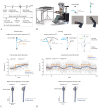Learning-to-learn as a metacognitive correlate of functional outcomes after stroke: a cohort study
- PMID: 39073359
- PMCID: PMC11559250
- DOI: 10.23736/S1973-9087.24.08446-6
Learning-to-learn as a metacognitive correlate of functional outcomes after stroke: a cohort study
Abstract
Background: Meta-learning is a metacognitive function for successful, efficient learning in various tasks. While it is possible that meta-learning is linked to functional recovery in stroke, it has not been investigated in previous clinical research on metacognition.
Aim: Examine if individual meta-learning ability is associated with functional outcomes.
Design: Cohort study.
Settings: Rehabilitation ward in Fujita Health University Hospital.
Population: Twenty-nine hemiparetic people after stroke.
Methods: The study measured individual sensorimotor adaptation rate, meta-learning (acceleration of adaptation through training), and Functional Independence Measure (FIM) motor effectiveness, an index of functional outcome measuring improvement in proficiency of activity of daily living (ADL). Participants performed visuomotor adaptation training sessions with their less-affected arm. They made arm-reaching movements to hit a target with cursor feedback, which was occasionally rotated with regard to their hand positions, requiring them to change the movement direction accordingly. Initial adaptation rate and meta-learning were quantified from pre- and post-training tests. The relationship between these indices of adaptation ability and FIM motor effectiveness was examined by multiple linear regression analyses.
Results: One participant was excluded before data collection in the motor task. In the remaining 28 individuals, the regression analyses revealed that FIM motor effectiveness positively correlated with meta-learning (µ=0.90, P=0.008), which was attenuated by age (µ=-0.015, P=0.005), but not with initial adaptation rate (P=0.08). Control analyses suggested that this observed association between FIM motor effectiveness and meta-learning was not mediated by patients' demographics or stroke characteristics.
Conclusions: This study demonstrates that those who can accelerate adaptation through training are likely to improve ADL, suggesting that meta-learning may be linked with functional outcomes in some stroke individuals. Meta-learning may enable the brain to keep (re-)learning motor skills when motor functions change abruptly due to stroke and neural recovery, thereby associated with improvement in ADL.
Clinical rehabilitation impact: Meta-learning is part of metacognitive functions that is positively associated with functional outcomes.
Conflict of interest statement
Figures


References
-
- Evans JR, Fisher RP. Eyewitness memory: balancing the accuracy, precision and quantity of information through metacognitive monitoring and control. Appl Cogn Psychol 2011;25:501–8. 10.1002/acp.1722 - DOI
-
- Flavell JH. Metacognition and cognitive monitoring: A new area of cognitive–developmental inquiry. Am Psychol 1979;34:906. 10.1037/0003-066X.34.10.906 - DOI
-
- Papleontiou-Louca E. The concept and instruction of metacognition. Teach Dev 2003;7:9–30. 10.1080/13664530300200184 - DOI
-
- Sugiyama T, Schweighofer N, Izawa J. Reinforcement learning establishes a minimal metacognitive process to monitor and control motor learning performance. Nat Commun 2023;14:3988. https://www.ncbi.nlm.nih.gov/entrez/query.fcgi?cmd=Retrieve&db=PubMed&l... 10.1038/s41467-023-39536-9 - DOI - PMC - PubMed
-
- Griffiths TL, Callaway F, Chang MB, Grant E, Krueger PM, Lieder F. Doing more with less: meta-reasoning and meta-learning in humans and machines. Curr Opin Behav Sci 2019;29:24–30. 10.1016/j.cobeha.2019.01.005 - DOI
MeSH terms
LinkOut - more resources
Full Text Sources
Medical

